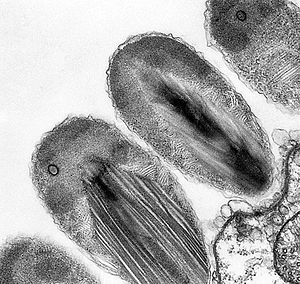Gastrocirrhidae
| Gastrocirrhidae | ||||||||||||
|---|---|---|---|---|---|---|---|---|---|---|---|---|
TEM-Aufnahme eines Stage-II-Epixenosoms an der Oberfläche von Euplotidium itoi (syn. Paraeuplotidium itoi). | ||||||||||||
| Systematik | ||||||||||||
| ||||||||||||
| Wissenschaftlicher Name | ||||||||||||
| Gastrocirrhidae | ||||||||||||
| Fauré-Fremiet, 1961[1][2] |
Die Gastrocirrhidae sind eine Familie von Wimpertierchen der Klasse Spirotrichea.[3][4]
Die Gastrocirrhidae leben planktonisch, alle Mitglieder sind marin oder psammophil (englisch psammophilic, im sandigen Substrat von Gewässern lebend). Sie haben eine relativ weite, nach vorne geöffnete Mundhöhle (en. buccal cavity, auch peristomial field ‚Peristomial-Bereich‘ genannt). Ihr Körper ist im Querschnitt fast rund; das vordere Ende des Körpers ist bemerkenswert abgestumpft (am ausgeprägtesten bei der Gattung Gastrocirrhus). Die linken Randzirren sind unauffällig oder nicht vorhanden, die Querzirren dagegen groß und in ungewöhnlichen Mustern angeordnet.[4][5][6]
Systematik
Familie Gastrocirrhidae Fauré-Fremiet, 1961[2][1]
- Gattung Cytharoides Tuffrau, 1975
- Spezies C. balechi Tuffrau, 1974
- Gattung Euplotidium Noland, 1937[7][8] – Spezies siehe Hauptartikel
- Gattung Gastrocirrhus Lepsi, 1928, mit Synonym Cirrogaster Ozaki & Yagiu, 1942
- Spezies G. monilifer (Ozaki & Yagiu, 1942), mit Synonymen:
- G. adhaerens Fauré-Fremiet, 1954
- G. trichocystus Ito, 1958
- G. adhaerens Fauré-Fremiet, 1954
- Spezies G. stentoreus Bullington, 1940
- Spezies G. sp. CXM08122201
- Spezies G. sp. GZCXM08122201
- Spezies G. monilifer (Ozaki & Yagiu, 1942), mit Synonymen:
- Gattung Paraeuplotidium Lei, Choi & Xu, 2002[9] – Spezies siehe Hauptartikel
Die Familie umfasste ursprünglich die drei Gattungen Cytharoides, Euplotidium und Gastrocirrhus;[1] dazu kam die 2002 von Euplotidium abgetrennte Gattung Paraeuplotidium.[9]
Einzelnachweise
- ↑ a b c NCBI Taxonomy Browser: Gastrocirrhidae, Details: Gastrocirrhidae Faure-Fremiet, 1961 (family); graphisch: Gastrocirrhidae, auf: Lifemap NCBI Version.
- ↑ a b WoRMS: Gastrocirrhidae Fauré-Fremiet, 1961. Die beiden Schalter „marine only“ und „extant only“ bitte deaktivieren.
- ↑ OneZoom: Spirotrichea
- ↑ a b EOL: Gastrocirrhidae
- ↑ John O. Corliss: The Ciliated Protozoa: Characterization, Classification and Guide to the Literature. Elsevier Science, 472 Seiten, 20. April 2016. ISBN 9781483154176, ISBN 1483154173. Hier: Seite 312.
- ↑ John O. Corliss: Chapter 20 - The Ciliate Taxa, including Families and their Genera. In: The Ciliated Protozoa — Characterization, Classification and Guide to the Literature. Second Edition, 1979, S. 206–326; doi:10.1016/B978-0-08-018752-5.50029-X.
- ↑ Lowell E. Noland: Observations on marine ciliates of the Gulf Coast of Florida. In: Transactions of the American Microscopical Society, Band 56, Nr. 2, S. 160–171, April 1937; doi:10.2307/3222944, JSTOR 3222944.
- ↑ Moselio (Elio) Schaechter: Ciliate 007. Auf: Schaechter Blog, American Society For Microbiology, 2014.
- ↑ a b Yanli Lei, Joong Ki Choi, Kuidong Xu: Morphology and Infraciliature of a New Marine Ciliate Euplotidium smalli n. sp. with Description of a New Genus, Paraeuplotidium n. g. (Ciliophora, Euplotida). In: Journal of Eukaryotic Microbiology, Band 49, Nr. 5, September/Oktober 2002, S. 402–406; doi:10.1111/j.1550-7408.2002.tb00219.x, PMID 12425528, Epub 11. Juli 2005.
Auf dieser Seite verwendete Medien
(c) Grosati in der Wikipedia auf Italienisch, CC BY-SA 3.0
Epixenosomen im Längsschnitt im TEM auf der Oberfläche von Euplotidium itoi (syn. Paraeuplotidium itoi). Man beachte die ungewöhnlich komplexe Struktur der Prokaryoten. Siehe auch Ciliate 007, WoRMS.

